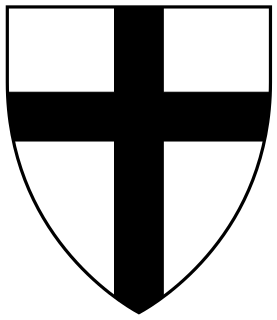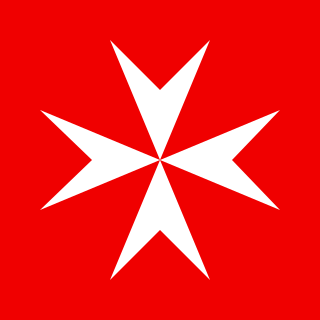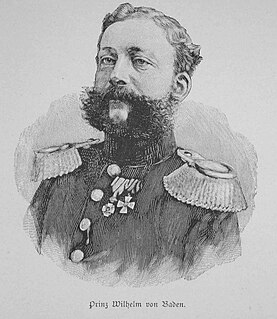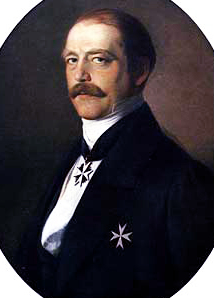
The Order of Brothers of the German House of Saint Mary in Jerusalem, commonly the Teutonic Order, is a Catholic religious order founded as a military order c. 1192 in Acre, Kingdom of Jerusalem.

William I or Wilhelm I of the House of Hohenzollern was King of Prussia from 2 January 1861 and the first German Emperor from 18 January 1871 to his death. William was the first head of state of a united Germany, and was also de facto head of state of Prussia from 1858 to 1861, serving as regent for his brother, Frederick William IV.

Frederick III was German Emperor and King of Prussia for ninety-nine days in 1888, the Year of the Three Emperors. Known informally as "Fritz", he was the only son of Emperor Wilhelm I and was raised in his family's tradition of military service. Although celebrated as a young man for his leadership and successes during the Second Schleswig, Austro-Prussian and Franco-Prussian wars, he nevertheless professed a hatred of warfare and was praised by friends and enemies alike for his humane conduct. Following the unification of Germany in 1871 his father, then King of Prussia, became the German Emperor. Upon Wilhelm's death at the age of ninety on 9 March 1888, the thrones passed to Frederick, who had by then been German Crown Prince for seventeen years and Crown Prince of Prussia for twenty-seven years. Frederick was suffering from cancer of the larynx when he died, aged fifty-six, following unsuccessful medical treatments for his condition.

George V was the last King of Hanover, the only child and successor of King Ernest Augustus. George V's reign was ended during the unification of Germany.

Prince Friedrich Karl of Prussia was the son of Prince Charles of Prussia (1801–1883) and his wife, Princess Marie of Saxe-Weimar-Eisenach (1808–1877). Prince Friedrich Karl was a grandson of King Frederick William III of Prussia and a nephew of Frederick William IV and William I. He was born at Schloss Klein in Berlin.

Prince Albert of Prussia was a Prussian general field marshal, Herrenmeister of the Order of Saint John from 1883 until his death, and regent of the Duchy of Brunswick from 1885, also until his death.

Augusta Victoria of Schleswig-Holstein was the last German empress and queen of Prussia by marriage to Wilhelm II, German Emperor.

Prince Albert William Henry of Prussia was a younger brother of German Emperor William II and a Prince of Prussia. He was also a grandson of Queen Victoria. A career naval officer, he held various commands in the Imperial German Navy, eventually rose to the rank of Grand Admiral and Generalinspekteur der Marine.

The Bailiwick of Brandenburg of the Chivalric Order of Saint John of the Hospital at Jerusalem, commonly known as the Order of Saint John or the Johanniter Order, is the German Protestant branch of the Knights Hospitaller, the oldest surviving chivalric order, which generally is considered to have been founded in Jerusalem in the year 1099 AD.

The Order of the Black Eagle was the highest order of chivalry in the Kingdom of Prussia. The order was founded on 17 January 1701 by Elector Friedrich III of Brandenburg. In his Dutch exile after World War I, deposed Emperor Wilhelm II continued to award the order to his family. He made his second wife, Princess Hermine Reuss of Greiz, a Lady in the Order of the Black Eagle.

The Order of the Red Eagle was an order of chivalry of the Kingdom of Prussia. It was awarded to both military personnel and civilians, to recognize valor in combat, excellence in military leadership, long and faithful service to the kingdom, or other achievements. As with most German orders, the Order of the Red Eagle could only be awarded to commissioned officers or civilians of approximately equivalent status. However, there was a medal of the order, which could be awarded to non-commissioned officers and enlisted men, lower ranking civil servants and other civilians.

Prince Oskar Karl Gustav Adolf of Prussia was the fifth son of Wilhelm II, German Emperor and Augusta Victoria of Schleswig-Holstein-Sonderburg-Augustenburg.

Prince Adalbert of Prussia was the third son of Wilhelm II, German Emperor by his first wife, Princess Augusta Victoria of Schleswig-Holstein.

The Royal Military Order of Saint George for the Defense of the Faith and the Immaculate Conception, also known as the Royal Bavarian House Equestrian Order of Saint George, was founded by Maximilian II Emanuel, Elector of Bavaria in 1726 to provide for a means of honouring the nobility and recognizing distinguished civil and military service. Its status as a Catholic Order was confirmed in a Papal Bull of 15 March 1728 specifically comparing the Order with the Teutonic Order, which had likewise been transformed from a Crusading Order to an exclusive chivalric religious institution for the Nobility.

Prince Frederick Charles Alexander of Prussia was a younger son of Frederick William III of Prussia. He served as a Prussian general for much of his adult life and became the first Herrenmeister of the Order of Saint John after its restoration as a chivalric order. Nevertheless, he is perhaps remembered more often for his patronage of art and for his sizable collections of art and armor.

Prince Karl Anton of Hohenzollern-Sigmaringen was head of the Princely House of Hohenzollern-Sigmaringen, Hohenzollern from 1869 and Prime Minister of Prussia. He was the son of Karl, Prince of Hohenzollern-Sigmaringen, who abdicated in favour of his son on 27 August 1848, and his first wife Marie Antoinette Murat, niece of Joachim Murat.
The state of Prussia developed from the State of the Teutonic Order. The original flag of the Teutonic Knights had been a black cross on a white flag. Emperor Frederick II in 1229 granted them the right to use the black Eagle of the Holy Roman Empire. This "Prussian Eagle" remained the coats of arms of the successive Prussian states until 1947.

The House Order of Hohenzollern was a dynastic order of knighthood of the House of Hohenzollern awarded to military commissioned officers and civilians of comparable status. Associated with the various versions of the order were crosses and medals which could be awarded to lower-ranking soldiers and civilians.

Prince Louis William Augustus of Baden was a Prussian general and politician. He was the father of Prince Maximilian of Baden, the last Minister President of the Kingdom of Prussia and last Chancellor of the German Empire. Wilhelm was a Prince of Baden, and a member of the House of Zähringen.

Prince Frederick Henry Charles of Prussia was a Prussian prince and army officer.



















